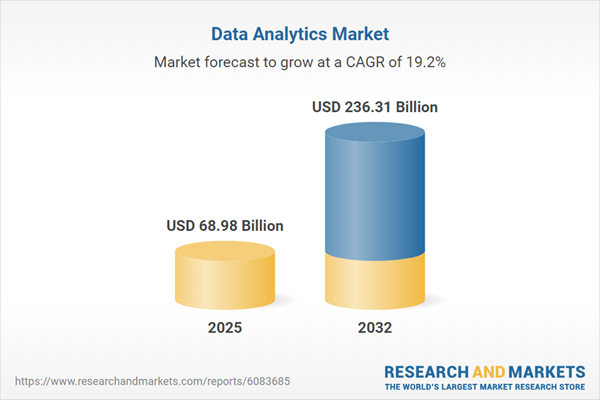Speak directly to the analyst to clarify any post sales queries you may have.
In today’s business landscape, the data analytics market positions enterprises to harness actionable insights, improve operational efficiency, and adapt quickly amid evolving regulatory and technology demands. Senior decision-makers are accelerating analytics adoption to foster scalable, resilient growth powered by informed strategy.
Market Snapshot: Data Analytics Market Size and Growth Trajectory
The global data analytics market expanded from USD 57.93 billion in 2024 to USD 68.98 billion in 2025, maintaining strong momentum with an expected CAGR of 19.21% through 2032. Revenues are projected to reach USD 236.31 billion. This trajectory is driven by increasing enterprise demand, rapid technological innovation, and significant investment in cloud-based and AI-powered analytics. The data analytics market continues to see robust adoption across sectors seeking digital transformation and competitive advantages.
Scope & Segmentation: Analysis of Key Market Segments and Regional Overview
- Product Type: The market is segmented into hardware (networking devices, servers, storage solutions), services (consulting, integration, support), and software (application software, operating systems, utility software), supporting enterprise-specific analytics objectives.
- Pricing Model: Enterprises have access to perpetual licensing, subscription-based, and usage-based procurement, offering flexibility and alignment with evolving financial planning needs.
- Industry Vertical: Analytics adoption spans banking and financial services, insurance, education, energy and utilities, government, healthcare, manufacturing, media, retail, telecommunications, IT, and transportation. Each sector leverages analytics to optimize decision-making and compliance.
- Deployment Mode: Both cloud-based and on-premise analytics solutions are deployed, allowing organizations to balance security, compliance, and scalability.
- Organization Size: Adoption patterns differ between large enterprises and SMEs, reflecting varying return-on-investment goals and operational integration strategies for analytics.
- Regional Coverage: The market encompasses the Americas (including North America—United States, Canada, Mexico—and Latin America such as Brazil, Argentina, Chile, Colombia, Peru), EMEA (Europe, Middle East, and Africa, covering United Kingdom, Germany, France, Italy, Russia, Spain, Netherlands, Sweden, Poland, Switzerland, United Arab Emirates, Saudi Arabia, Qatar, Turkey, Israel, South Africa, Nigeria, Egypt, Kenya), and Asia-Pacific (China, India, Japan, Australia, South Korea, Indonesia, Thailand, Malaysia, Singapore, Taiwan), highlighting diverse adoption trends and local market dynamics.
- Company Analysis: The report examines leading companies, including Microsoft Corporation, SAS Institute Inc., International Business Machines Corporation, Oracle Corporation, SAP SE, Salesforce.com, Inc., Google LLC, Amazon Web Services, Inc., Teradata Corporation, and MicroStrategy Incorporated, with a focus on competitive innovation, strategic alliances, and partnership ecosystems.
Key Takeaways: Strategic Insights for Data Analytics Market Stakeholders
- Artificial intelligence and machine learning are shifting analytics from simple reporting to proactive, prescriptive applications, empowering better forecasting and real-time business interventions.
- Data complexity is on the rise, leading organizations to implement scalable architectures capable of supporting high volumes of structured and unstructured data streams for more nuanced decision-making.
- The transition toward cloud-native and hybrid analytics platforms promotes flexibility and shortens deployment cycles, meeting varied business model requirements and compliance standards.
- Effective data governance, with focus areas such as privacy, auditability, and data lineage, is essential in managing organizational risk and addressing stringent regulatory frameworks.
- Integrated analytics solutions that combine hardware, software, and managed services facilitate simplified vendor management and improved interoperability, streamlining deployment for enterprises.
- Strategic partnerships and acquisitions in the technology sector are enhancing the depth and accessibility of analytics offerings, expanding service portfolios and advancing enterprise digital initiatives.
Tariff Impact: US Trade Policy Influences on Cost Structures
Recent United States tariffs have raised capital costs for servers, storage, and network infrastructure, encouraging a faster shift to cloud-based deployment models among enterprises. In response to new cost structures and shifting procurement preferences, software vendors are adjusting pricing models, while service providers increasingly emphasize outcome-based engagements. Enterprises are consolidating vendor relationships and seeking comprehensive analytics solutions to stabilize spending and manage supply chain risks.
Methodology & Data Sources
This research incorporates thorough secondary analysis, reviewing public filings, patents, and regulatory documents. Primary data derived from executive interviews adds real-world perspectives on challenges and opportunities in the data analytics sector. An expert panel validated the conclusions for accuracy and transparency.
Why This Report Matters
- Guides senior executives in benchmarking analytics strategies, navigating transformation, and identifying leading technology providers for global expansion and compliance.
- Clarifies critical market drivers, procurement challenges, and segment trends, supporting confident and timely decision-making aligned with organizational priorities.
- Delivers insight on emerging risks and vendor strategies, enabling stakeholders to respond to market changes and optimize investment in analytics solutions.
Conclusion
This report enables leadership teams to effectively leverage analytics in evolving regulatory and technological environments. By adopting adaptable, well-governed analytics frameworks, organizations are equipped to unlock value and support future-ready strategic direction.
Table of Contents
3. Executive Summary
4. Market Overview
7. Cumulative Impact of Artificial Intelligence 2025
Companies Mentioned
The companies profiled in this Data Analytics market report include:- Microsoft Corporation
- SAS Institute Inc.
- International Business Machines Corporation
- Oracle Corporation
- SAP SE
- Salesforce.com, Inc.
- Google LLC
- Amazon Web Services, Inc.
- Teradata Corporation
- MicroStrategy Incorporated
Table Information
| Report Attribute | Details |
|---|---|
| No. of Pages | 182 |
| Published | October 2025 |
| Forecast Period | 2025 - 2032 |
| Estimated Market Value ( USD | $ 68.98 Billion |
| Forecasted Market Value ( USD | $ 236.31 Billion |
| Compound Annual Growth Rate | 19.2% |
| Regions Covered | Global |
| No. of Companies Mentioned | 11 |









